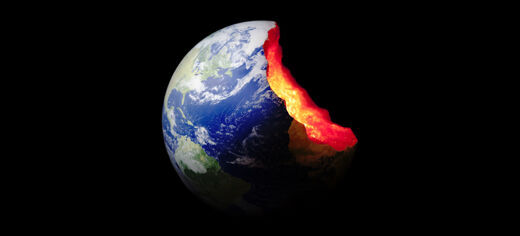
Scientists at the University of Leeds have solved a 300-year-old riddle about which direction the centre of the Earth spins.
The Earth’s inner core, made up of solid iron, ‘superrotates’ in an eastward direction – meaning it spins faster than the rest of the planet – while the outer core, comprising mainly molten iron, spins westwards at a slower pace.
Although Edmund Halley – who also discovered the famous comet – showed the westward-drifting motion of the Earth’s geomagnetic field in 1692, it is the first time that scientists have been able to link the way the inner core spins to the behavior of the outer core. The planet behaves in this way because it is responding to the Earth’s geomagnetic field.
The findings, published in Proceedings of the National Academy of Sciences, help scientists to interpret the dynamics of the core of the Earth, the source of our planet’s magnetic field.
In the last few decades, seismometers measuring earthquakes travelling through the Earth’s core have identified an eastwards, or superrotation of the solid inner core, relative to Earth’s surface.
“The link is simply explained in terms of equal and opposite action”, explains Dr Philip Livermore, of the School of Earth and Environment at the University of Leeds. “The magnetic field pushes eastwards on the inner core, causing it to spin faster than the Earth, but it also pushes in the opposite direction in the liquid outer core, which creates a westward motion.”
The solid iron inner core is about the size of the Moon. It is surrounded by the liquid outer core, an iron alloy, whose convection-driven movement generates the geomagnetic field.
The fact that the Earth’s internal magnetic field changes slowly, over a timescale of decades, means that the electromagnetic force responsible for pushing the inner and outer cores will itself change over time. This may explain fluctuations in the predominantly eastwards rotation of the inner core, a phenomenon reported for the last 50 years by TkalÄić et al. in a recent study published in Nature Geoscience.
Other previous research based on archeological artefacts and rocks, with ages of hundreds to thousands of years, suggests that the drift direction has not always been westwards: some periods of eastwards motion may have occurred in the last 3,000 years. Viewed within the conclusions of the new model, this suggests that the inner core may have undergone a westwards rotation in such periods.
The authors used a model of the Earth’s core which was run on the giant super-computer Monte Rosa, part of the Swiss National Supercomputing Centre in Lugano, Switzerland. Using a new method, they were able to simulate the Earth’s core with an accuracy about 100 times better than other models.
The study was a collaboration between the University of Leeds and the Swiss Federal Institute of Technology, Zurich.
Further information
Please contact Ben Jones, Press Officer, University of Leeds, on 0113 34 38059 or email B.P.Jones@leeds.ac.uk
The full paper, P.W. Livermore, R. Hollerbach and A. Jackson, “Electromagnetically driven westward drift and inner-core superrotation in Earth’s core,” Proc. Natl. Acad. Sci. USA (2013), is available via www.pnas.org/cgi/doi/10.1073/pnas.1307825110